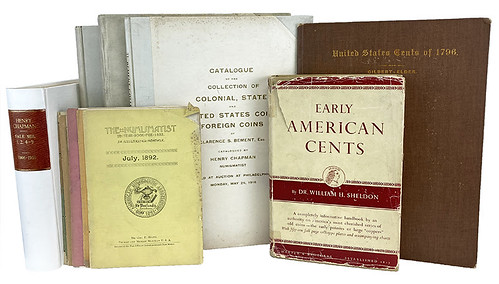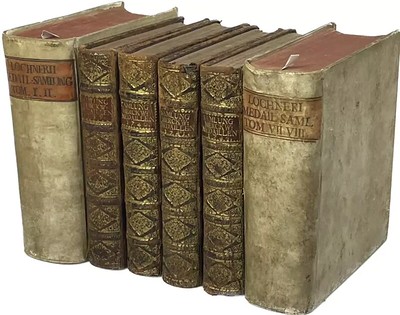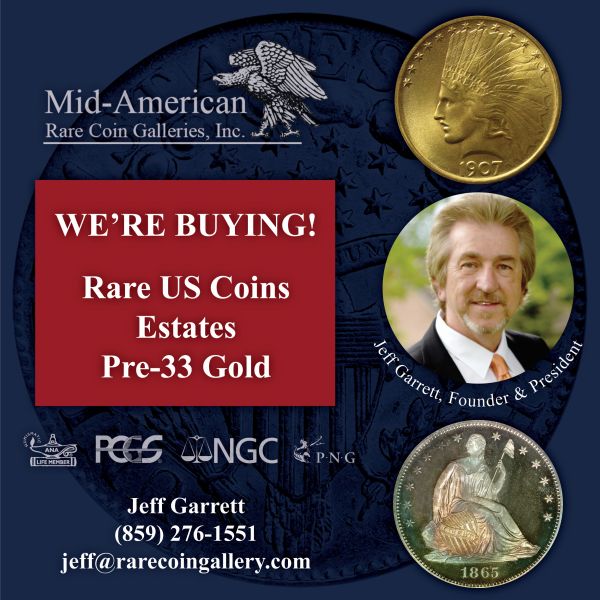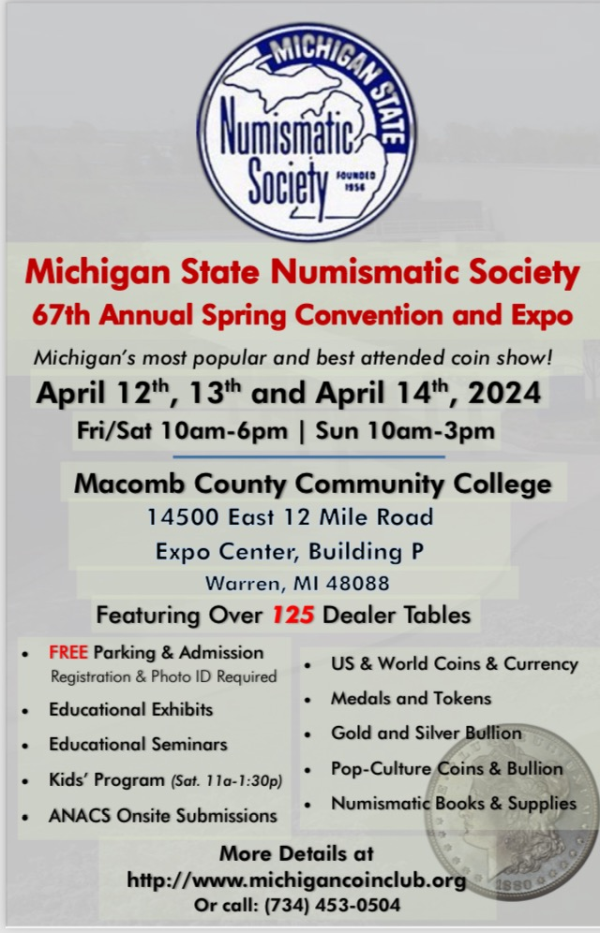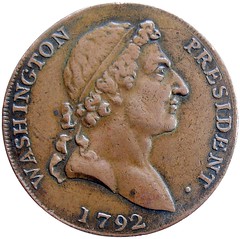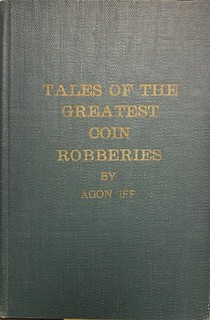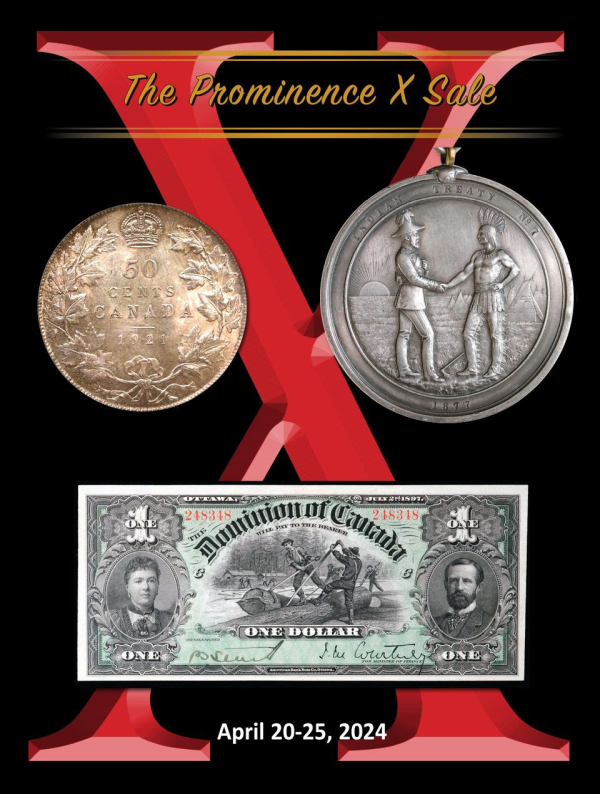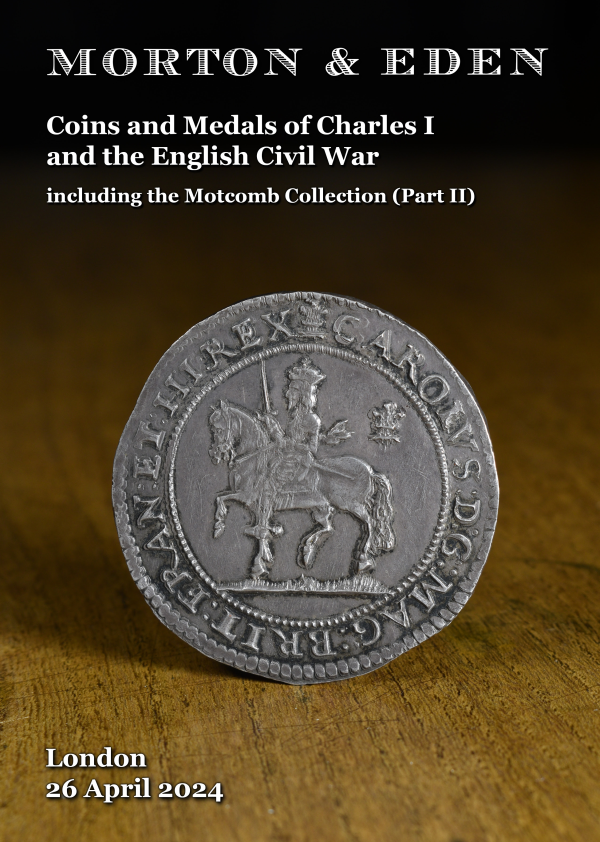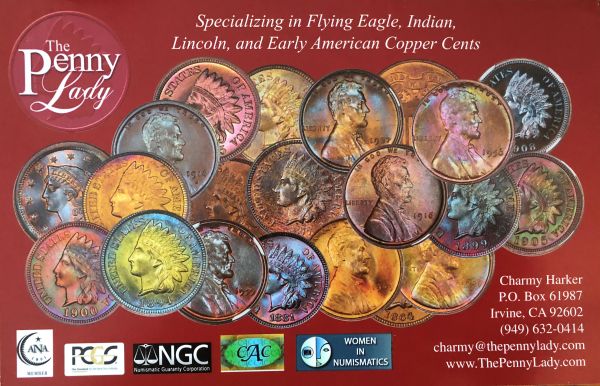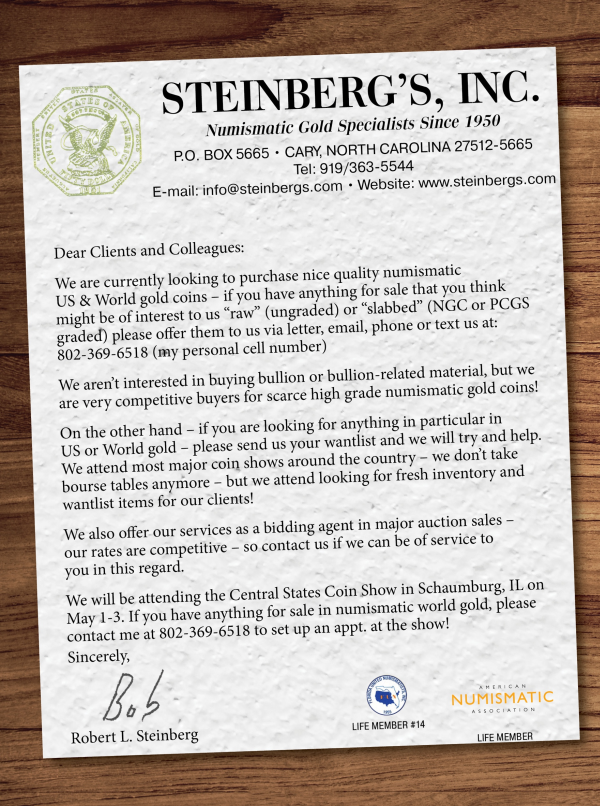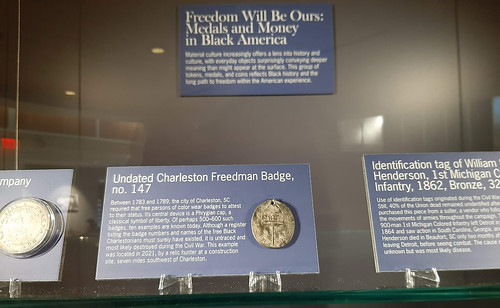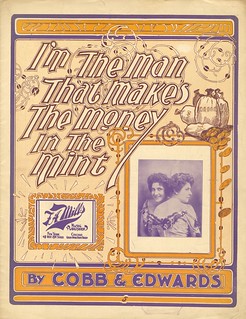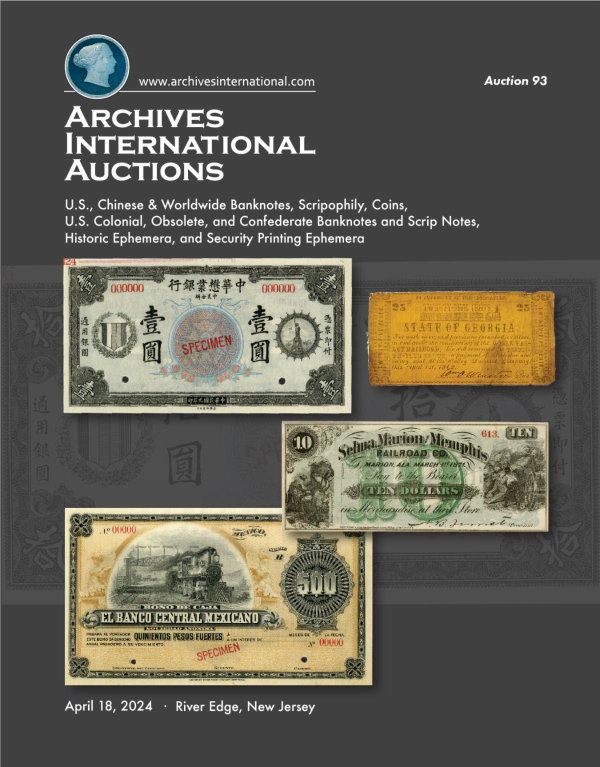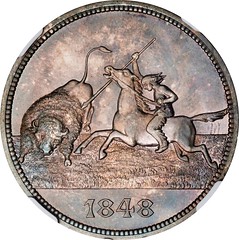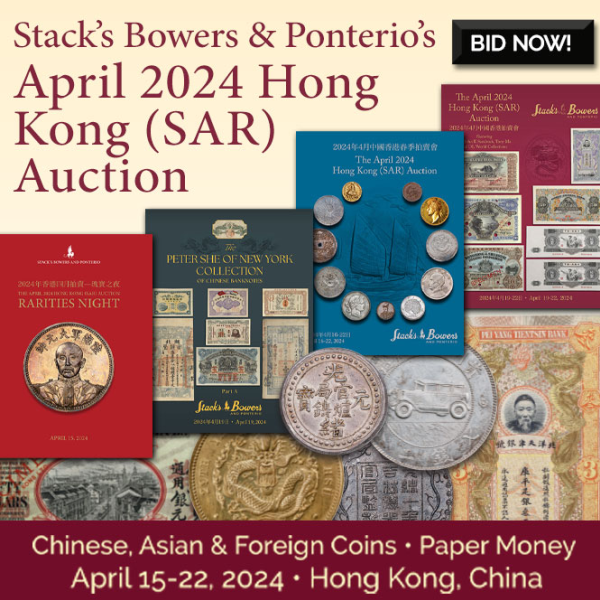
Visit our NBS Sponsors
About UsThe Numismatic Bibliomania Society is a non-profit association devoted to the study and enjoyment of numismatic literature. For more information please see our web site at coinbooks.org SubscriptionsThose wishing to become new E-Sylum subscribers (or wishing to Unsubscribe) can go to the following web page link MembershipThere is a membership application available on the web site Membership Application To join, print the application and return it with your check to the address printed on the application. Print/Digital membership is $40 to addresses in the U.S., and $60 elsewhere. A digital-only membership is available for $25. For those without web access, write to: Jeff Dickerson, Treasurer AsylumFor Asylum mailing address changes and other membership questions, contact Jeff at this email address: treasurer@coinbooks.org SubmissionsTo submit items for publication in The E-Sylum, write to the Editor at this address: whomren@gmail.com BUY THE BOOK BEFORE THE COINSale CalendarWatch here for updates! |
- WAYNE'S WORDS: THE E-SYLUM APRIL 7, 2024
- NBS 2024 CHARITY AUCTION DONATIONS SOUGHT
- LANG LITERATURE AUCTION 2
- BERNARD ROME (1934-2024)
- NNP ADDS HISTORIC WHITMAN TITLES
- CALIFORNIA EXPOSITION ELONGATED PIECES
- VIDEO: NUMISMATIC HOMETOWN COLLECTING
- ON ENGRAVER JOHN GREGORY HANCOCK
- U.S. MINT CERTIFIED FIRST STRIKE COINS
- NOTES FROM E-SYLUM READERS: APRIL 7, 2024
- KEY BRIDGE RELIC MEDALS PROPOSED
- BANK OF CANADA MUSEUM SENSORY SUNDAYS
- 2024 ANA MONEY TALKS SPEAKERS SOUGHT
- VOCABULARY TERMS: PICKLE, PICKLING
- HENRY CLAY EZEKIEL (1846-1930)
- CHAPMAN-ASSEMBLED GOLD DOLLARS SURFACE
- NUMISMAGRAM MEDAL SELECTIONS: APRIL 7, 2024
- MORTON & EDEN APRIL 2024 SALE
- NUMISMATIC NUGGETS: APRIL 7, 2024
- WAYNE'S NUMISMATIC DIARY: APRIL 7, 2024
- WATTON MEDIEVAL SILVER COIN HOARD
- HOUTHI COIN ROLLOUT ROILS YEMEN FACTIONS
- IN-N-OUT BURGER COINS
- 1898 TRANS-MISSISSIPPI EXPOSITION MEDAL
- CURL NOBEL MEDAL IN CHEMISTRY SOLD
- THE 1852 ADELAIDE INGOTS
- WOMEN OF THE BANK OF ENGLAND
- MOUNTAINS OF MARIJUANA MOOLAH
- $30 MILLION L.A. CASH HEIST
Content presented in The E-Sylum is not necessarily researched or independently fact-checked, and views expressed do not necessarily represent those of the Numismatic Bibliomania Society.
WAYNE'S WORDS: THE E-SYLUM APRIL 7, 2024
 New subscribers this week include:
Mike Strub, courtesy Kathy Freeland, and
Jim Burdick.
Welcome aboard! We now have 7,298 subscribers.
New subscribers this week include:
Mike Strub, courtesy Kathy Freeland, and
Jim Burdick.
Welcome aboard! We now have 7,298 subscribers.
Thank you for reading The E-Sylum. If you enjoy it, please send me the email addresses of friends you think may enjoy it as well and I'll send them a subscription. Contact me at whomren@gmail.com anytime regarding your subscription, or questions, comments or suggestions about our content.
This week we open with an NBS update, a numismatic literature auction, one obituary, updates from the Newman Numismatic Portal, and sadly, no new books. Maybe next week.
Other topics this week include the Whitman Numismatic Journal, hometown collecting, U.S. Mint first strike coins, relic medals, sensory Sundays, collector H. C. Ezekiel, fixed price and auction offerings, a medieval coin hoard, Houthi coins, a Nobel medal in Chemistry, Adelaide ingots, and mountains of marijuana moolah.
To learn more about curious medals, Bernard Rome, California Expo elongated coins, engraver John Gregory Hancock, the Third Cent coined in new Mint – Philadelphia", Key Bridge coins, ANA Money Talks, pickling,
Civil War tokens, the Motcomb Collection, Cat Cay Island tokens, J.S.G. Boggs, the Charleston Freedman Badge,
and the Man That Makes the Money In the Mint, read on. Have a great week, everyone!
Wayne Homren
Editor, The E-Sylum
NBS 2024 CHARITY AUCTION DONATIONS SOUGHT
Each year at the ANA World's Fair of Money, the Numismatic Bibliomania Society conducts a charity auction to raise funds for the organization. NBS President Len Augsburger submitted this announcement of this year's auction. What could you contribute? -Editor
NBS Solicits Donations for 2024 Charity Auction
The NBS requests donations of numismatic literature for the 2024 Charity Auction, which will be held at the ANA convention in August. The Charity Auction covers a good portion of the NBS annual expenses, and we gratefully acknowledge past donors and bidders. While material at varied price points is welcome, we especially encourage donations of literature valued at $100 and up. Top honors from last year's sale went to Carl Würtzbach's annotated and plated copy of Henry Chapman's Bement sale (1916), donated by David Steine, which realized $3,000. Donations may be sent to NBS president Len Augsburger at 16 N. Fiore Parkway, Vernon Hills, IL 60061.
Link to previous NBS Charity Auction catalogs:
https://nnp.wustl.edu/library/auctioncompanydetail/512295
To read earlier E-Sylum articles, see:
2023 NBS BENEFIT AUCTION
(https://www.coinbooks.org/v26/esylum_v26n32a03.html)
NBS CHARITY AUCTION RAISES RECORD AMOUNT
(https://www.coinbooks.org/v26/esylum_v26n33a02.html)
LANG LITERATURE AUCTION 2
The second numismatic literature auction from Numismatic Antiquarian Bookshop Lang closes April 28. Here's the announcement. -Editor
We are pleased to inform you that the Numismatic Antiquarian Bookshop Lang will be holding its second literature auction on 28 April 2024 its second literature auction.
- Date: April 28, 2024
- Location: Live auction via Auex
- Time: Start at 14:00 CEST
Alternatively, you can also use the auction platforms Biddr and Sixbid to place your pre-bids.
After the great success of our first auction, we cordially invite you to participate in this event. Discover a wide range of high-quality numismatic literature, including rare books, catalogs and specialist journals from various eras and fields of numismatics.
Among the highlights of our auction you will find:
Lochner, J.H.
Collection of curious medals. In which a curious coinage, mostly of modern medals, is selected weekly, and not only diligently presented in copper, but also sufficiently explained by a historical explanation, but now, as well as with complete registers, [...] brought to light. First to eighth year (complete). Nuremberg 1737 - 1744. 8 parts bound in 6 volumes. Full leather and full vellum, bumped and scuffed.
Babelon, E.
Les Rois de Syrie, d'Arménie et de Commagène. Paris 1890. vol. 1: CCXXII, 268 pp. With some illustrations and a fold-out. Vol. 2: 32 tfn. Modern half leather.
Berliner Blätter für Münz-, Siegel- und Wappenkunde, Berlin.
Vol. 1 - 6 from 1863 - 1873. IV, 391 p.; VI, 392 p.; VIII, 380 p.; IV, 378 p.; VIII, 384 p.; VIII, 391 p. with numerous tfn. 6 vols. Uniform full cloth.
Enrich your collection with unique treasures and deepen your knowledge of the fascinating world of numismatics.
We look forward to welcoming you to our second auction.
If you have any questions, please feel free to contact us at any time. The best way to reach us is by e-mail at info@numismatisches-antiquariat.de.
To read the earlier E-Sylum article, see:
NUMISMATISCHES ANTIQUARIAT LANG LAUNCHES
(https://www.coinbooks.org/v26/esylum_v26n46a03.html)
BERNARD ROME (1934-2024)
Numismatic market pioneer Bernard Rome passed away in West Palm Beach, Florida on March 9, 2024. Here's an excerpt from the Vermonter's obituary. -Editor
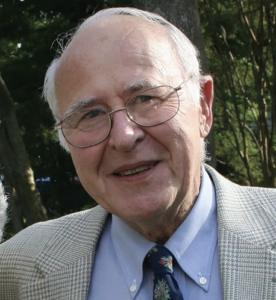 Bernard Rome was born in Burlington, July 18, 1934, but his family moved to Clinton Ave. in Rutland when he was 2 years old. Rome attended Rutland High School (Class of 1952) where he later returned as a graduation speaker. He was a lifelong member of the Rutland Jewish Center, which is where he was when Pearl Harbor was attacked in 1941, launching the U.S. into World War II. Bernard's father, Louis, was the oldest man drafted in the state of Vermont and served as a chaplain's assistant in the war. Rome was predeceased by his father, Louis, his mother, Celia (Katz), and his brother, Newman.
Bernard Rome was born in Burlington, July 18, 1934, but his family moved to Clinton Ave. in Rutland when he was 2 years old. Rome attended Rutland High School (Class of 1952) where he later returned as a graduation speaker. He was a lifelong member of the Rutland Jewish Center, which is where he was when Pearl Harbor was attacked in 1941, launching the U.S. into World War II. Bernard's father, Louis, was the oldest man drafted in the state of Vermont and served as a chaplain's assistant in the war. Rome was predeceased by his father, Louis, his mother, Celia (Katz), and his brother, Newman.
The family opened a business in Rutland in the 1960s which later turned into the Ski Shack and moved in 1976 to the corner of Route 4 and the Killington Access Road, where it flourished for decades.
Rome earned a B.S. in business from the University of Vermont (Class of 1956). He spent his life as an entrepreneur, developing ideas with a creativity, passion, and commitment that led to some notable successes, including the Rome Report, Teletrade, and a technology that began the modern-day tracking of TV advertising, which he sold to Time Warner. He lived life seeing the opportunity for improvement, whether in grocery shopping or plastic wrap or stock trading. He loved to learn and build expertise in new fields.
Rome returned full time to Vermont in 1991, for what he called retirement. He expanded the Ski Shack, opened other businesses in the area, and worked hard to build a campus in Killington to help expand the housing, education and cultural options in the region. His strong beliefs about the state education finance legislation (Act 60) led him to run for governor in 1998.
For CoinWeek Julie Abrams wrote:
"My encounter with Bernie occurred during my senior year at the University of Vermont when he graced us as a guest speaker in 1986. His talk, which focused on utilizing cutting-edge technology for rare coin trading through bid-and-ask systems and digitized voice boards, left an indelible mark on me.
"Upon graduation, at the recommendation of our mutual professor, Bernie hired me to help him get his ideas off the ground. Together, we embarked on a pioneering venture, birthing the first computerized auction company, Teletrade. From its nascent bid/ask system to the innovative auction model employing VHS ‘catalogs' and later transitioning to computer dummy
terminals for bidders, Bernard fearlessly navigated the realms of creativity and adaptation. Our collaboration was a joyous odyssey, culminating in auctions commencing and concluding within a single day, thrice weekly, featuring over a thousand lots in each auction."
I never met him, but certainly knew the name from The Rome Report. Can anyone tell us more about his numismatic career? -Editor
To read the complete obituary, see:
Obituary: Bernard Rome, 89
(https://mountaintimes.info/obituary-bernard-rome-89/)
To read the complete CoinWeek article, see:
Bernard Rome, Entrepreneur and Numismatist – In Memoriam
(https://coinweek.com/bernard-rome-entrepreneur-numismatist-julie-abrams-in-memoriam/)
NNP ADDS HISTORIC WHITMAN TITLES
Great news for researchers! Long-awaited new additions to the Newman Numismatic Portal are two classic Whitman periodicals. Project Coordinator Len Augsburger provided the following report. -Editor
Whitman Brands and Newman Numismatic Portal Announce Availability of Historic Whitman Titles
 The 1960s brought an intense public interest in coin collecting with the withdrawal of silver coinage from circulation. Coin stores appeared in nearly every city of a certain size, and increasingly thick numismatic publications were targeted at the collecting public. One of these titles was the Whitman Numismatic Journal, published monthly from 1964 to 1968. Edited by Ken Bressett, the Journal contained articles by Q. David Bowers, R. W. Julian, Neil Shafer, and other prominent writers. Whitman also published the Whitman Coin Supply Merchandiser, which was aimed at retailers of numismatic supplies. This publication contains little-known tidbits on various Whitman products of the day, such as books like The Fantastic 1804 Dollar. More recently, David Lange used this publication as part of his extensive research into coin albums and folders.
The 1960s brought an intense public interest in coin collecting with the withdrawal of silver coinage from circulation. Coin stores appeared in nearly every city of a certain size, and increasingly thick numismatic publications were targeted at the collecting public. One of these titles was the Whitman Numismatic Journal, published monthly from 1964 to 1968. Edited by Ken Bressett, the Journal contained articles by Q. David Bowers, R. W. Julian, Neil Shafer, and other prominent writers. Whitman also published the Whitman Coin Supply Merchandiser, which was aimed at retailers of numismatic supplies. This publication contains little-known tidbits on various Whitman products of the day, such as books like The Fantastic 1804 Dollar. More recently, David Lange used this publication as part of his extensive research into coin albums and folders.
CDN Publishing and Newman Numismatic Portal are pleased to announce that both of these publications are now available with full-view on Newman Portal, with the Whitman Coin Journal posted at
https://nnp.wustl.edu/library/publisherdetail/532083, while the Whitman Coin Supply Merchandiser is available at
https://nnp.wustl.edu/library/publisherdetail/535094. Ken Bressett noted We greatly enjoyed producing these publications in the 1960s and I am pleased they are being shared with today's collectors.
Whitman Brands publishes the Red Book and is a leading dealer of coin collecting folders, albums, and supplies. The Newman Numismatic Portal is the world's largest online numismatic library and includes over 70,000 auction sale catalogs, periodicals, reference works, and archival resources.
Link to Whitman Numismatic Journal on Newman Portal:
https://nnp.wustl.edu/library/publisherdetail/532083
Link to Whitman Coin Supply Merchandiser on Newman Portal:
https://nnp.wustl.edu/library/publisherdetail/535094
Link to Whitman Brands:
https://whitmanbrands.com/
CALIFORNIA EXPOSITION ELONGATED PIECES
Another new addition to the Newman Numismatic Portal is Benjamin Gastfriend's research on California Exposition Elongated Pieces. Project Coordinator Len Augsburger provided the following report. -Editor
Benjamin Gastfriend Publishes on Elongated Pieces of the California Expositions (1915-1916)
 The 1914 opening of the Panama Canal served as the theme for two expositions: the Panama-Pacific International Exposition held in San Francisco in 1915, and the Panama-California (International) Exposition held in San Diego in 1915-1916. Elongated coins, first widely introduced as souvenirs at the 1893 World's Columbian Exposition in Chicago, had become a popular feature of expositions, but the details surrounding their production have remained enigmatic. Here, using archival documents, Gastfriend demonstrates that the elongated coins produced at both 1915-1916 California expositions were the creation of the same man, Joseph Weis, who also operated other exposition concessions.
The 1914 opening of the Panama Canal served as the theme for two expositions: the Panama-Pacific International Exposition held in San Francisco in 1915, and the Panama-California (International) Exposition held in San Diego in 1915-1916. Elongated coins, first widely introduced as souvenirs at the 1893 World's Columbian Exposition in Chicago, had become a popular feature of expositions, but the details surrounding their production have remained enigmatic. Here, using archival documents, Gastfriend demonstrates that the elongated coins produced at both 1915-1916 California expositions were the creation of the same man, Joseph Weis, who also operated other exposition concessions.
These documents also reveal the legal and financial arrangements between Weis and exposition organizers. Together, this work contributes new pieces of documentary evidence related to early elongated coin production. This research was sponsored by the Eric P. Newman Numismatic Education Society (EPNNES), which awarded a Newman Grant to Gastfriend in 2023.
Image: Example of CAL-PPIE-8, depicting the aviator Art Smith. Rolled on an 1892 Indian Head cent. From Stack's Bowers Galleries auction of the Raymond W. Dillard collection, September 2013, lot 4051. Image courtesy Stack's Bowers Galleries.
Link to Elongated Coins from the 1915-1916 California Expositions: Historical and Biographical Context on Newman Portal:
https://nnp.wustl.edu/library/book/636786
VIDEO: NUMISMATIC HOMETOWN COLLECTING
The David Lisot Video Library on the Newman Numismatic Portal can be found at:
https://nnp.wustl.edu/library/multimediadetail/522852
We highlight one of his videos each week in The E-Sylum. Here's one from 2005 with Arthur Fitts speaking about hometown collecting. -Editor
If you are looking for a new and different collecting interest try your own home town. There may be merchant tokens and good-fors, commemorative tokens and medals, even obsolete scrip and national bank notes. See examples like this for the town of Framingham, Massachusetts.
Speaker(s): Arthur M. Fitts, III.
This topic never gets old - new collectors are born every day, and many start or end their collecting journey with numismatic items related to their hometowns. -Editor
To watch the complete video, see:
Numismatic Hometown Collecting
(https://nnp.wustl.edu/library/book/557173)
ON ENGRAVER JOHN GREGORY HANCOCK
Pete Smith submitted these notes on the engraver of the 1792 Washington Roman Head Cent. An electrotype was discussed in last week's issue. -Editor
Sometimes I think I could spend half my time attempting to correct errors published by others. Although our book, 1792: Birth of a Nation's Coinage, debunked many of the myths associated with the coinage, authors continue to repeat those myths.
The recent April Fools
edition of The E-Sylum includes comments so foolish that I am required
to respond. Under the heading of WAYNE'S NUMISMATIC DIARY: MARCH 31, 2024,
there is a photograph of a 1792 Washington Roman Head Cent. It is described as, certainly the high-water mark for the 1792 pattern issues.
I have a minor quibble with this statement. It was not one of the 1792 pattern issues. They were not made at the U. S. Mint. They did not meet the statutory requirements for U. S. coinage. They were not speculative issues produced with the hope of getting a foreign contract to produce American coins.
I have a major quibble with a later statement, Hancock was just 17 when these were made, and he clearly intended them for what they were.
A long article on Hancock was The Hancocks, Die Engravers
published in The Conder Collectors Journal issue for Summer 2003. This is a quote from that article:
His dates of birth and death were unknown to most writers so the convention was to use
fl.
(flourished) to indicate dates of his career. Eimer gives his dates as fl. 1783-1805. Forrer gives his dates as circa 1775-1815. Brown gives his dates as fl. 1775-1821. Peck gives the dates as 1775-1815 without the fl.
convention. Breen copied the 1775-1815 dates from Peck.
Breen expanded this by stating that Hancock was 16 years old when he cut dies for the 1791 dated patterns. (Making him 8 when he produced the 1783 Priestley medal). Also 1791 is the year his son was born. Breen was an excellent researcher but his conclusions may be subject to criticism. In this case, Breen's statements about Hancock's age must be ignored.
The Birmingham Gazette of November 11, 1805, announced the death of John Gregory Hancock
on November 2, 1805, at age 55, setting his date of birth around 1750.
Then there is the statement, he clearly intended them for what they were.
Now, 232 years later, we still do not know what they were.
Bonham's sold Eric Newman's Roman Head cent in their auction of June 11, 2018, as lot 28. The description said, the die work is by young 17-year-old John Gregory Hancock, a precocious young lad who was producing advanced die work before he reached double digits in age.
One should not believe everything one reads in auction lot descriptions. Sometimes that information may include foolish mistakes.
To read the earlier E-Sylum article, see:
WAYNE'S NUMISMATIC DIARY MARCH 31, 2024
(https://www.coinbooks.org/v27/esylum_v27n13a23.html)
THE BOOK BAZARRE
U.S. MINT CERTIFIED FIRST STRIKE COINS

Last week Roger Burdette shared a letter from the Director of the Mint enclosing "...the first One Cent Bronze Coin struck in the United States mints in the year 1912." I asked if any such coins have turned up with accompanying Mint documentation. Daryl Haynor submitted these images of a 1909 Philadelphia Indian Cent with "First piece coined" documentation. Thanks! -Editor
"I have a frame hanging on my office wall. It bears a 1901 Philadelphia strike Indian Cent, a letter from Assistant Coiner Robert Clark addressed to Superintendent Henry K. Boyer, along with a couple envelopes.
I acquired the unit about 35 years ago. I have never undertaken any research on it and have accepted it at face value. Reputedly it is the Third Cent coined in new Mint – Philadelphia / Oct. 1 . / 1901
. Interesting to say the least."
Indeed, quite interesting! Thanks, everyone.
These are evidence of an occasional but approved Mint practice in 1901, 1909 and 1912. Likely this took place in intervening years as well. A new research question is - when did this practice begin and end? What are the earliest and latest such coins that might be found with their documentation? -Editor
Roger Burdette adds:
"We already know that Philadelphia made "Master coins" or production samples for some of the mints to introduce new designs (Eagles at New Orleans, some of the false "branch mint proofs" are likely these pieces. But was there something more routine in cranking out "souvenir first strike coins" for the Secretary, or was this a kind of competition between mints to see who could make the first coin of the new year? (That seems implied from the 1912 letter....)
"PS: This 1912 letter is in a large batch of presscopy volumes digitized last month, so I have not gone through everything. It's the only letter of it's kind I've seen so far."
To read the complete article, see:
NOTES FROM E-SYLUM READERS: MARCH 31, 2024 : 1912 First Strike Coins
(https://www.coinbooks.org/v27/esylum_v27n13a12.html)
NOTES FROM E-SYLUM READERS: APRIL 7, 2024
2024 April Fool Numismatic Literature
A reader writes:
"I hope that we will be seeing a book review on Tales of the Greatest Coin Robberies
. Sounds like a fascinating and fun read. What a find. Not knowing the contents makes it that much more fun."
Pete Smith asked:
"Aprille Phoole Publishing?"
Daniel Fearon writes:
"Another splendid E-Sylum. I'm so glad that David Pickup informed us all of the new publication from Aprille Phoole Publishing, the Encyclopedia of Slabbed Coins. I hope he will be swamped with orders."
 Well, those two pieces were April Fool items. The Tales book actually exists in physical form - it's an old Redbook rebound as a gag item. It's part of my next library consignment to Kolbe & Fanning. Dave Fanning kindly provided the photo. It was earlier in the library of former ANA Governor Ray Byrne, although I've forgotten how and where I obtained this. Fun item.
Well, those two pieces were April Fool items. The Tales book actually exists in physical form - it's an old Redbook rebound as a gag item. It's part of my next library consignment to Kolbe & Fanning. Dave Fanning kindly provided the photo. It was earlier in the library of former ANA Governor Ray Byrne, although I've forgotten how and where I obtained this. Fun item.
The French coin with the Sower wearing boxing gloves? Real. -Editor
To read the earlier E-Sylum articles, see:
NOTES FROM E-SYLUM READERS: MARCH 31, 2024 : New Book on Slabbed Coins
(https://www.coinbooks.org/v27/esylum_v27n13a12.html)
WAYNE'S NUMISMATIC DIARY MARCH 31, 2024
(https://www.coinbooks.org/v27/esylum_v27n13a23.html)
A Wall Street Journal article by Peter Funt explores the art of pranking. -Editor
A Golden Age of practical joking came between 1920 and 1950, when pranksters were particularly daring. One influential character of the period was the illustrator Hugh Troy, a man who could not tolerate the status quo. He once bought a bench and waited until a cop tried to arrest him as he stole
it from the park. While in the military he filed a bogus Daily Flypaper Report,
listing every insect caught in the previous 24 hours, and soon the Army demanded similar paperwork from other officers. In 1935 Troy made a fake human ear out of corned beef and placed it in a display box at New York's Museum of Modern Art with a sign: This is the ear which Vincent van Gogh cut off and sent to his mistress, a French prostitute, Dec. 24, 1888.
It drew a large crowd.
To read the complete article, see:
(https://www.wsj.com/arts-culture/the-art-of-the-april-fools-day-prank-071505df)
Vocabulary: Giftees and Uncirculated Medals
Daniel Fearon continues:
"But then here was the account of this year's Maundy ceremony at Worcester Cathedral where, in Case Wickman's article, reprinted from Vanity Fair, she refers to the recipients of the Money as ‘giftees', a word not even recognised by my spell-check and insulting to each and every one of the pensioners who to whom the Maundy Purses was given, each selected for their contribution to their local community.
Whilst on the subject of incorrect English, six of the 10 medals you illustrate from Dick Johnson's collection are described as ‘Uncirculated'. Surely ALL medals in the collection are uncirculated as it was never intended for them to enter circulation.
Well, I'm glad I've got that off my chest!"
Agreed - "Awardees" or "Honorees" would be more appropriate for the Maundy ceremonies. As for medals, while not intended for circulation, they can indeed acquire wear and damage over the years, which must be noted in a lot description. Yes, most will remain uncirculated, but there will be exceptions. -Editor
To read the earlier E-Sylum articles, see:
MAUNDY COINAGE THEN AND NOW
(https://www.coinbooks.org/v27/esylum_v27n13a24.html)
DICK JOHNSON COLLECTION SELECTIONS
(https://www.coinbooks.org/v27/esylum_v27n13a21.html)
Vocabulary: Maundy
Michael T. Shutterly writes:
"Just finished reading - and enjoying - the March 31 issue. Delighted to see so much material on areas of my particular interest, such as Byzantina. Great stuff.
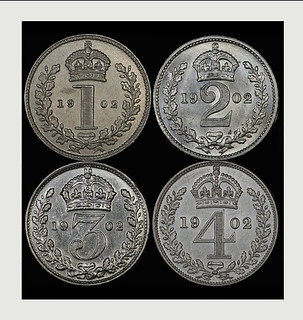 "I do have one nit to pick, not with respect to your work, but in the "Maundy Coinage Then and Now" excerpt in the 3/31 issue. The second paragraph quoted in the piece states that "Many sources describe Maundy Thursday as the Christian holy day just before Good Friday, and that it commemorates the Last Supper of Jesus Christ with the Apostles. The term maundy refers to the foot-washing ceremony that Jesus Christ originally performed on his disciples."
"I do have one nit to pick, not with respect to your work, but in the "Maundy Coinage Then and Now" excerpt in the 3/31 issue. The second paragraph quoted in the piece states that "Many sources describe Maundy Thursday as the Christian holy day just before Good Friday, and that it commemorates the Last Supper of Jesus Christ with the Apostles. The term maundy refers to the foot-washing ceremony that Jesus Christ originally performed on his disciples."
"Well. "Maundy" does not actually refer to the foot-washing, but to what Jesus said at the time. He told the Apostles "A new commandment I give you, that you love one another; even as I have loved you, that you also love one another. In Vulgate Latin, the English "new commandment" is "novum mandatum." The Vulgar Latin mandatum became the Old French mande which became the Middle English Maundy. Mandatum is of course also the root of the English word "mandate."
"A small nit indeed, but language nerds thrive on such things.
"Thanks for all you do in the E-Sylum."
Thanks for setting us straight! -Editor
To read the Oxford English Dictionary definition, see:
Maundy
NOUN
(https://www.oed.com/dictionary/maundy_n)
To read the earlier E-Sylum articles, see:
MAUNDY COINAGE THEN AND NOW
(https://www.coinbooks.org/v27/esylum_v27n13a24.html)
Query: French Medal Rarity
Jim Burdick writes:
"Does anyone know of any books or resources that explain the rarity of French medals and jetons? Many of the medals I have are marked with a F.
or Fecit which means he made it
. I think some of these are actually cast by the engraver himself!!! Or can this also mean an engravers special proof?
Here are some examples. I currently have 108 certified and graded items in my collection and growing. I am working on my own catalog."
Nice medals! 'Fecit' generally refers to the designer or engraver, but not the manufacturer. -Editor
KEY BRIDGE RELIC MEDALS PROPOSED
Jeff Starck writes:
"I like this idea! A letter to the editor writer for the Baltimore Sun proposes a relic medal be made to raise funds for those affected by the tragic collapse of the Key Bridge. Of course, they're not called relic medals in this column, but "coins" but you can't win them all!"
 Key Bridge coins: They worked for the U.S.S. Constellation.
Key Bridge coins: They worked for the U.S.S. Constellation.
The steel salvaged from the deck of the Dali and the bottom of the Patapsco River can certainly be piled up and sold for salvage for a few hundred dollars a ton, or maybe we can do better. Let's stamp coins from the steel salvaged from Francis Scott Key Bridge with all proceeds going to help the businesses and employees whose livelihoods are affected by the tragedy and extended harbor closing and those families who lost loved ones in the collapse.
These coins could be made as keepsakes, with part of the price donated to a fund to be managed and fairly distributed to our affected community. They could be struck with the image of the bridge on one side and a commemoration on the other. Make them available online. I'd easily pay $15 to $20, and with tens of thousands of tons of steel being removed that could be worth millions of dollars. We might get help from other sources as well, but why not make something good from something bad?
When I was 10 years old in 1964, my grandfather took me to see the Constellation, a wreck at the time moored in the Inner Harbor. He bought me a coin struck from the shiny metal trimmings known as brightwork
of the ship emblazoned with an image of her sailing. It raised money for her renovations and provided me with a lifetime free pass to walk her decks. More than three decades later, I took the kids and that coin to see her again, and sure enough, I held up that coin as I approached the Constellation kiosk, still 15 feet away and the attendant immediately waived me through. I still have it. That coin helped to fund and promote restoration of that ship that still floats in our Inner Harbor today more than 60 years since I first visited her.
This is worth a chance. How do we get this done, Baltimore?
To read the complete article, see:
Key Bridge collector coins could help families hurt by collapse | READER COMMENTARY
(https://www.baltimoresun.com/2024/04/06/key-bridge-collector-coins/)
I like the idea, too. Steel and iron may be harder to work with than copper, but relic medals have been produced in many different metals. Here's an image of an order form for the Constellation medals. See the earlier articles for more information. -Editor
To read the earlier E-Sylum article, see:
THE CONSTELLATION SOUVENIR MEDAL
(https://www.coinbooks.org/esylum_v14n27a09.html)
BANK OF CANADA MUSEUM SENSORY SUNDAYS
A Canadian Coin News article discusses 'Sensory Sundays' at the Bank of Canada Museum. -Editor
The Bank of Canada Museum presents Sensory Sundays,
a special initiative designed to accommodate individuals with sensory sensitivities.
On select Sundays throughout 2024, visitors to the Ottawa, Ont., Bank of Canada Museum will have the opportunity to immerse themselves in a sensory-friendly environment filled with engaging activities. From hands-on exploration of artifacts to guided tours showcasing touchable exhibits, Sensory Sundays promise an enriching experience for all attendees.
The Museum has implemented several features to enhance the sensory experience, including reduced ambient sounds and additional directional signage to aid navigation. Complimentary noise-canceling headphones will also be available at the front desk for those who may benefit from them, while a designated quiet area offers a sanctuary for individuals seeking respite from sensory stimuli.
The remaining Sundays this year include March 31, April 28, May 26, June 16, July 28, Aug. 25, Sept. 29, Oct. 27, and Nov. 24. Programming includes an early opening from 9-10 a.m. and sensory activities continuing until noon, offering an inclusive and enriching cultural experience.
To read the complete article, see:
‘Sensory Sundays': inclusive museum experience
(https://canadiancoinnews.com/sensory-sundays-inclusive-museum-experience/?mc_cid=4dee0a8310&mc_eid=f8a25e655c)
For more information, see:
SENSORY SUNDAYS
(https://www.bankofcanadamuseum.ca/visit/sensory-sundays/)
2024 ANA MONEY TALKS SPEAKERS SOUGHT
It's never too soon to plan for an ANA World's Fair of Money® convention. E-Sylum readers are perfectly suited to speak on their numismatic specialties, and the ANA is looking for Money Talks presenters. The deadline is approaching, so don't miss your chance! -Editor
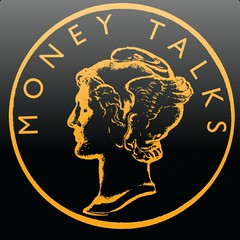 American Numismatic Association (ANA) members are encouraged to share their ideas and research with fellow hobbyists by delivering a Money Talks presentation at the 2024 World's Fair of Money in Chicago (Rosemont), Aug. 6-10 at the Donald E. Stephens Convention Center.
American Numismatic Association (ANA) members are encouraged to share their ideas and research with fellow hobbyists by delivering a Money Talks presentation at the 2024 World's Fair of Money in Chicago (Rosemont), Aug. 6-10 at the Donald E. Stephens Convention Center.
Those interested in giving a Money Talks presentation should submit an online proposal at money.org/numismatic-events/money-talks. Proposals are due no later than Friday, April 12. The talks will take place Thursday Aug. 8 and Friday Aug. 9.
The informative 30- to 45-minute Money Talks are presented by some of the hobby's most noted authorities and allow collectors to share their expertise with the numismatic community. Presentations from previous shows include "Siege Notes: The Currency of War," "Collection or Load of Rubbish? What Makes the Difference" and "Curious Currency of the World."
Money Talks presentations should be accompanied with digital images.
Proposals must be submitted online using the form at money.org/events/money-talks. For questions or additional information, contact Paula Knepper, the ANA's eLearning program coordinator, at (719) 482-9852 or email pknepper@money.org.
VOCABULARY TERMS: PICKLE, PICKLING
Here's another entry from Dick Johnson's Encyclopedia of Coin and Medal Terminology. -Editor
Pickle, Pickling. Use of a mild acid solution to clean, remove tarnish or corrosion from a metallic surface. Most pickle solutions are made of dilute quantities of sulfuric or nitric acid. If particularly stubborn tarnish exists (as certain oxides) then potassium dichromate is added to the acid solution. A pickle bath (or barrel tumbling, see WHITENING) is often used on blanks to clean them prior to coining or striking. In casting, a pickle bath removes scale as well as other surface impurities.
Some pickling action etches the surface; a process known as descaling. Pickling is widely used in REPOUSSÉ work to remove pitch from the completed work. As with some chemical cleaners, pickling leaves the treated piece with an ACTIVATED SURFACE which will tone or retarnish as it ages unless some further action is done to prevent this.
To read the complete entry on the Newman Numismatic Portal, see:
Pickle, Pickling
(https://nnp.wustl.edu/library/dictionarydetail/516481)
HENRY CLAY EZEKIEL (1846-1930)
E-Sylum Feature Writer and American Numismatic Biographies author Pete Smith submitted this article on Cincinnati collector Henry Clay Ezekiel. Thanks! -Editor
I recently wrote about Peter Mougey of Cincinnati. While doing research on him, I came across an article in The Cincinnati Inquirer of June 4, 1911, which mentioned another local collector:
For many years he has paid particular attention to coins and medals, and since the death of Thomas C. Cleneay and Peter Mougey is the most notable numismatist in the city.
The collector continued the narrative, Most of these collectors have passed away, and their
collections dispersed. Mr. Peter Mougey, recently deceased, had the best collection of the United
State coinage, while my own collection is the most extensive in all the various branches of
numismatics, I also have a very large collection of autographs, stamps, historical and literary
curiosities, which is possibly the most extensive of any private collection in the United States.
In another part of the article was stated, Mr. Henry Clay Ezekiel, which is his real name, has for
a number of years been collecting everything possible relating to the
Early Money of
Cincinnati.
and has written several papers on the subject, particularly for Greve's History of
Cincinnati, for numismatic journals, and an extensive one read at Columbus, Ohio, last year
before the Ohio Numismatic Society.
Ezekiel was born in Richmond, Virginia, on January 30, 1846, the son of Jacob Ezekiel (1812-1899) and Catherine DeCastro Ezekiel (1818-1891). He served with the Confederate Army during the Civil War as a guard for Union prisoners.
Ezekiel began to collect coins at age 13. He claimed that he was in the office of Richmond banker Edward Cohen around 1860 when a negro came in and sold a lot of silver coins that included an 1804 dollar.
He moved to Cincinnati in 1870 and worked in the auction and commission business. He was the president of the Ezekiel and Bernheim Company conducting sales of art, books and rugs for more than fifty years. Each year he conducted an auction for choice seats at the Cincinnati Symphony Orchestra.
H. C. Ezekiel placed an ad in the June 1904 issue of The Numismatist before he was listed as an ANA member. He was looking to buy all kinds of early Cincinnati money. In the issue of April 1905, he placed an ad looking for various priced auction catalogs.
He joined the ANA in 1905 as member 724. For the July 1911 issue of The Numismatist
(24:236), he submitted an article on Cincinnati Civil War Store cards.
This was a listing of
merchants with no coin descriptions. He followed with Cincinnati Civil War Tokens
for the
issue of April 1912 (25:119), Civil War Card Money of Cincinnati, 1861-1865
in the issue of
June 1912 (25:218).
He wrote The
for the issue of May 1913 (26:242). This included a brief
biography for David Benjamin Sterritt who had a grocery store at 541 Main Street.
D. B. S.
War Token
In the April 1918 issue of The Numismatist, Ezekiel offered the coin cabinet of Peter Mougey for sale.
Ezekiel specialized in the study of early money in Cincinnati from the foundation of the city in 1788 through the end of the Civil War. The June 4, 1911, article in the Cincinnati Inquirer described this money in some details. This was an unusually long article on numismatics in a local paper. In the early days trade was done through barter. Montroville Dickeson believed that coal disks found in mounds near Cincinnati were used as currency. It was Dickeson's habit to think any disk found in a mound was used as currency.
The first bank in Cincinnati, The Miami Exporting Company, was founded in 1803. That bank failed in 1842. Ezekiel studied the history of early banking and collected the banknotes.
During the Civil War, many banks and local businesses printed currency for use in trade. One Cincinnati lithographer also produced counterfeits of Confederate currency to pass across the Ohio river in the South.
Ezekiel published a list of counterfeit detectors and bank note reporters published in Cincinnati during 1841 to 1863.
Gold coins were struck in 1849 for the Cincinnati Mining and Trading Company. The name reflects the ownership group and not the source of the gold, which was in California. Ezekiel advertised that he wished to purchase specimens but without success.
Cincinnati collector H. A. Ratterman assembled a collection of card money
or printed tokens
good for products like bread or milk or coal. Ezekiel purchased that collection from one of the
heirs.
Ezekiel knew John Stanton, a prolific issuer of Civil War tokens, and wrote about him while he was still living at age 82. Stanton could not remember how many he produced, but there were hundreds. Stanton also produced Sutlers' Checks.
Robert Wright was a large customer for Stanton's tokens. He had a standing order for 10,000 tokens a week and bought more than a million pieces over the course of the war.
Ezekiel wrote brief biographical sketches for James Murdock, Jr., William Spencer and John Stanton. Collectors of Civil War tokens are indebted to Ezekiel for recording this information shortly after the tokens were made.
Four dry goods companies in Cincinnati issued encased postage pieces while only one other dry goods company in New York was known to have produced one.
Ezekiel wrote about the early collectors in Cincinnati. The Western Museum Society opened the Cincinnati Museum in 1818. Letton's Museum operated after 1829. He wrote in 1911 that the Cincinnati Art Museum, the Ohio Historical Society and the Van Wormer Library currently maintained collections of coins and medals.
Notable Cincinnati private collectors included Dr. M. L. Amick, James Bindley, Enoch T, Carson, Robert M. Brazner, Thomas C. Cleneay, T. Bishop Disney, Robert Downing, Alfred S. Field, Louis J. Hauck, James J, Hughes, Joseph Kluber, Robert Leslie, Abraham Mayer, Samuel A. McCune, Robert W. Mercer, Peter Mougey, Dr. William L. Prescott, Henry Probasco, Charles C, Reakirt, Henry Sayre, J. M. Tilton, and Joseph Zanoni. Few of them were notable enough to be mentioned in American Numismatic Biographies.
Henry Clay Ezekiel acquired intact the J. Murdock, Jr, Collection of Civil War tokens about 1917. This included tokens made in Cincinnati by John Stanton and Murdock. After picking out a few to enhance his collection, he consigned the remainders to Thomas Elder for his sale of March 20, 1918. Elder eventually sold Ezekiel coins in five of his auctions.
Henry Clay Ezekiel was married in 1894 to Jessie Myers Ezekiel (1856-1929). He died on September 18, 1930, and is buried with his wife at Walnut Hill Jewish Cemetery in Evanston, Ohio.
What an amazing collecting history and numismatic legacy. -Editor
To read the earlier E-Sylum article, see:
PETER MOUGEY (1842-1908)
(https://www.coinbooks.org/v27/esylum_v27n11a17.html)
CHAPMAN-ASSEMBLED GOLD DOLLARS SURFACE
A high-grade collection of gold dollars recently surfaced in Philadelphia; here's the announcement. -Editor
A previously unreported, nearly complete date set of 19th-century United States $1 denomination gold coins assembled by legendary Philadelphia dealer Henry Chapman has been revealed by Matador Rare Coins in New York City.
Stored until recently in a Philadelphia bank vault and safe deposit boxes for more than a century, the formerly hidden collection has 51 Liberty Head and Indian Princess Head dollars struck between 1849 and 1889 as well as eight U.S. commemorative gold dollars struck in the first decades of the 20th-century.
The set, now described as The Henry Chapman Collection of $1 Gold, has been owned and securely stored for generations by a Philadelphia area family. The current owners thought their ancestors' coins might be worth about $50,000, but they are now insured for $2 million, according to Luis Martinez, founder and president of Matador Rare Coins He is working with the set's owners who want to remain anonymous.

Chapman personally began assembling this collection for a banking family in 1899 and the coins have remained in the family's possession continuously for generations. The set includes several coins among the finest known examples of their kind today, and there are gold dollars struck at the Charlotte, Dahlonega, New Orleans, Philadelphia and San Francisco Mints,
said Martinez.
When I received the coins, I carefully reviewed each example. Housed in the original envelopes from Henry Chapman's shop in Philadelphia, a number of the coins carried exuberant eye appeal. I was truly in awe as I reviewed each coin one at a time. I knew then that this collection could truly be a national treasure,
stated Martinez.
All the coins are now certified by Professional Coin Grading Service (www.PCGS.com) with the Chapman pedigree indicated on the encapsulated insert label.
"PCGS is proud to have been able to unite these coins with their impressive pedigree at the September 2023 Long Beach Expo," said PCGS President Stephanie Sabin. "This historic collection boasts not only magnificent rarities and grades, but also hails from the cabinets of renowned collector Henry Chapman. Preserving the coins themselves and their history is an honor."
The grading results were beyond my expectations with a number of the coins reaching the finest known tier,
said Martinez. When I shared the results with the owners, they were astonished and filled with disbelief. A collection they would have sold for about $50,000 could now potentially bring in well over seven figures at auction!
 Among the highlights are an 1863 gold dollar graded PCGS MS68 CAC and tied for finest known; 1881 graded PCGS PR66 Deep Cameo and tied for finest known among the remaining survivors of only 87 struck; 1884 graded PCGS PR67+ Cameo CAC tied with one other for finest known; and an 1887 gold dollar graded PCGS MS67+ CAC. An example of the 1875 $1 gold – with a small mintage of only 400 -- is graded PCGS AU58 CAC.
Among the highlights are an 1863 gold dollar graded PCGS MS68 CAC and tied for finest known; 1881 graded PCGS PR66 Deep Cameo and tied for finest known among the remaining survivors of only 87 struck; 1884 graded PCGS PR67+ Cameo CAC tied with one other for finest known; and an 1887 gold dollar graded PCGS MS67+ CAC. An example of the 1875 $1 gold – with a small mintage of only 400 -- is graded PCGS AU58 CAC.
The U.S. began making $1 gold pieces in 1849, a year after the start of the California Gold Rush. A little smaller than a modern U.S. dime, the gold dollars were struck over the years with three different designs – Liberty Head from 1849 to 1854; Indian Princess Small Head from 1854 to 1856; and the Indian Princess Large Head type from 1856 to 1889,
explained Martinez.
Over the years and at various times, five mints were involved in striking $1 gold: Charlotte, North Carolina; Dahlonega, Georgia; New Orleans, Louisiana; Philadelphia, Pennsylvania; and San Francisco, California.
The commemorative gold coins in the collection include a 1903 Louisiana Purchase McKinley graded PCGS MS68 and tied for finest known; a 1905 Lewis and Clark graded PCGS MS67; 1915-S Panama-Pacific graded MS67; 1917 McKinley graded PCGS MS67, and a 1922 Grant With Star variety graded PCGS MS67+ CAC.
Additional, specific information about each of the coins in The Henry Chapman Collection of $1 Gold will be released soon, according to Martinez.
John Albanese, founder of CAC, was surprised to learn about the long-concealed gold dollars and then view them in person: I've been around the numismatic block a few times since the 1970s and thought we've seen probably everything there is to see in great collections. I almost fell off the chair when these coins came in. It's nice to know there are still great coins out there. It gives us hope.
Henry Chapman and his brother Samuel Hudson (S.H.) Chapman were well-known late 19th and early 20th-century Philadelphia coin dealers and auctioneers. Numismatic bibliographer Pete Smith describes the Chapman brothers as the first career coin dealers in the United States
and who were innovative with the use of photographic plates to illustrate their catalogs.
For additional information about the set, contact Matador Rare Coins at 877-757-3665 or visit www.MatadorRareCoins.com.
NUMISMAGRAM MEDAL SELECTIONS: APRIL 7, 2024
Jeremy Bostwick with Numismagram forwarded these five items from his most recent upload of new material to his site. This upload featured a great mix of topics and themes, spanning the realm of historical medals to modern, and with some colorful toning thrown in as well. For all of the new items, please visit https://www.numismagram.com/inventory.
Great medals! -Editor
102784 | GREAT BRITAIN. England. Elizabeth I "Phoenix Badge" oval cast silver Medal. Issued circa mid-late 18th century (40mm x 44mm, 29.10 g, 12h). + HEI MIHI QVOD TANTO VIRTVS PERFVSA DECORE NON HABET ETERNOS INVIOLATA DIES / ELISABETHA D G ANG FR ET HIB REGINA (Alas! That virtue endued with so much beauty, should not uninjured enjoy perpetual life), bust left wearing ruffled collar and with hair in bonnet // FELICES ARABES MVNDI QVIBVS VNICA PHŒNIX PHŒNICEM REPARAT DEPEREVNDO NOVAM/ O MISEROS ANGLOS MVNDI QVIBVS VNICA PHŒNIX VLTIMA FIT NOSTRO TRISTIA FATA SOLO (Happy Arabs whose only Phoenix reproduces by its death a new Phoenix. Wretched English whose only Phoenix becomes, unhappy fate, the last in our country), Phoenix standing slightly left amid flames, with wings spread; above, crowned monogram of Elizabeth. Edge: Some filing marks as made. Cf. MI 124/70 (for prototype); cf. Eimer 48B (same). Choice Extremely Fine. Attractively toned, with some wear upon the high points and great relief on the obverse. A rare and very desirable type, with originals being virtually unobtainable. $985.
The originals of this type, almost never encountered, are believed to date to 1574, as the dress of the queen is less decorated than normal, and in that year, she issued a proclamation that condemned the use of excess ornamentation. Given the sentiments expressed in the legends, and the idea of a loss of the queen, it may indicate that it was worn by those personally attached to her at a time at which the plague was raging in London.
To read the complete item description, see:
102784 | GREAT BRITAIN. England. Elizabeth I oval cast silver "Phoenix Badge"
(https://www.numismagram.com/product-page/102784)
102509 | GERMANY. Kronprinz Wilhelm silver Medal. Issued 1914. World War I series: The Siege of Longwy (35mm, 18.70 g, 12h). By H. Splieth for O. Oertel in Berlin. WILHELM KRONPRINZ D DEUTSCH REICHES U V PREUSSEN, bust facing, wearing Totenkopfhelm (Prussian kucsma of the Death's Head Hussars) // DEM SIEGER VON LONGWY, soldier in medieval armor left, weiling sword and shield; panel in background with battle scene. Edge: SILBER 990. Zetzmann 4018. PCGS SP-63. Most attractively toned, with tremendous vibrant iridescence and a prooflike nature in the fields. $545.
Friedrich II der Große (Frederick the Great) created a regiment of hussar cavalrymen in the Prussian army and adorned their busbys (tall military hat) with the Totenkopf symbol, the skull and crossbones. This symbol continued to be worn by various prominent German military figures in World War I, such as August von Mackensen, Kaiser Wilhelm II, and the kaiser's son, Kronprinz Wilhelm.
To read the complete item description, see:
102509 | GERMANY. Kronprinz Wilhelm silver Medal.
(https://www.numismagram.com/product-page/102509)
102508 | GERMANY. Generalfeldmarschall Anton Ludwig August von Mackensen silver Medal. Issued 1915 (34mm, 17.24 g, 12h). By F. Eue and H. Grünthal in Berlin. GENERALFELDMARSCHALL von MACKENSEN, uniformed bust facing slightly right // Soldier advancing right, holding banner and sword, and leading other soldiers into combat. Edge: SILBER 800. Zetzmann 4101. PCGS SP-63. A great prooflike nature, with some colorful iridescent toning on part of the obverse. $395.
Nicknamed "the Last Hussar," Anton Ludwig August von Mackensen was born in 1849 in the Kingdom of Prussia and would go on to have a successful military career during his 95 years, seeing him serve not just the Kingdom of Prussia, but also the North German Confederation, the German Empire, the Weimar Republic, and the Third Reich. Dying just a few months after the close of WWII in Europe, he would even see the post-war allied occupation of Germany. During his military career, some of his most important roles came during WWI, with much of his focus being in the east with campaigns in Serbia, Romania, and the Eastern Front. His nickname emanated from his part in the Hussar Brigade (Leib-Husaren-Brigade), an elite Prussian regiment originally founded by (Friedrich II der Große) Frederick the Great as the Death's Head Hussars (Totenkopfhusaren). This regiment was known for their black uniforms and rather imposing 'skull and crossbones'-adorned busby. Throughout his life, even long after the dissolution of the German Empire, von Mackensen would continue wearing his uniform, standing in stark contrast to the Nazi uniforms of the Third Reich.
To read the complete item description, see:
102508 | GERMANY. Generalfeldmarschall von Mackensen silver Medal.
(https://www.numismagram.com/product-page/102508)
102787 | GERMANY. World War cast bronze Medal. Issued 1919. A lamentation on the recently concluded world war (66mm, 105.83 g, 1h). By R. Förster in München. Female personification of War-Fury (Kriegsfürie) striding left, nude save for billowing cloak, with right hand and hair terminating in numerous serpents, and holding torch in left hand; at a distance in background, cityscape set ablaze and in ruin // View of the Earth, focused upon Africa, with numerous areas of smoke arising from Europe; around and below, banner reading WELTKRIEG 1914–1919; stars and crescent moon in background. Edge: Plain. Klose 22.10; The Art of Devastation, pp. 87 & fig. 12; Kluge & Weisser A27. Choice Mint State. Light brown surfaces, with a subtle matte nature. Ex David Nicholas Silich Collection (acquired from Howard & Frances Simmons, September 2003). $895.
While many medals from the German side offer more optimistic and jubilant messages and iconography at the outset of the war, this imagery began to change as the war ravaged on. By the time that the war concluded, the full scale of its effects caused the tune of many medals, such as this one, to change dramatically. In this piece, Förster depicts War-Fury as a hideous and cruel mistress, leaving a trail of carnage behind her. On the reverse, the lonely nature of the Earth is conveyed, with chaos raging all across Europe—all while the rest of the surrounding cosmos is seemingly at peace and in normal order.
To read the complete item description, see:
102787 | GERMANY. World War cast bronze Medal.
(https://www.numismagram.com/product-page/102787)
102788 | GREAT BRITAIN. Ivory Exploitation silvered bronze Medal. Issued 2013 (102mm, 642.2 g, 12h). By Kyosun Jung. Forepart of sad, tuskless elephant standing right // Pattern evoking an elephant's curled tusk, with this legend spiralling outward: "THOUSANDS OF ELEPHANTS DIE EACH YEAR SO THAT THEIR TUSKS CAN BE CARVED INTO RELIGIOUS OBJECTS. CAN THE SLAUGHTER BE STOPPED?". Edge: Plain. The Medal 63, p. 61. As made. Highly argent surfaces, with incredible texture. Unique in this format, with just one made in silver (with the Goldsmiths' Company), one silvered (the present specimen) and three in bronze (sold to private clients by the artist). As such, a tremendous opportunity for the representative in silvered bronze. Ex David Nicholas Silich Collection (acquired from Howard & Frances Simmons, December 2015 [who acquired it directly from the artist herself]). $795.
Born in South Korea and immigrating to England, Kyosun Jung established a breakthrough with her 2013 design, "Ivory Exploitation," which, according to the medalist, Kyosun "...entered into the British Art Medal Society (BAMS) Student Medal Project. Eleven UK colleges and universities took part in this scheme, which resulted in 125 design submissions. From a short list, I won the Pangolin Editions Prize for my modeling, the use of both sides of the medal and the lettering." The output for this poignant and powerful piece, as mentioned above, is incredibly paltry. The lone silver example resides with The Goldsmiths' Company, the manufacturer, and the three bronze examples were sold by the artist herself to private clients, leaving this sole silvered bronze specimen. The metrological breakdown of this unique piece is as follows: 75.8% silver, 13.1% copper, 9.1% tin.
To read the complete item description, see:
102788 | GREAT BRITAIN. Ivory Exploitation silvered bronze Medal.
(https://www.numismagram.com/product-page/102788)
MORTON & EDEN APRIL 2024 SALE
Morton & Eden's London sale of coins and medals of Charles I and the English Civil War includes Part II of the Motcomb Collection and closes April 26, 2024. Here's an overview from the catalogue's introduction. -Editor
 The Motcomb Collection contains spectacular Charles I silver coins of exceptional rarity and
quality, many of the provincial and siege pieces being numbered amongst the finest known
specimens. Gold coins are represented by three Tower mint unites, three Oxford triple unites
and a Scottish unite by Nicholas Briot. Chosen with great discernment, most of the coins are
accompanied by tickets confirming their distinguished earlier provenances and, sometimes, by
more recent notes.
The Motcomb Collection contains spectacular Charles I silver coins of exceptional rarity and
quality, many of the provincial and siege pieces being numbered amongst the finest known
specimens. Gold coins are represented by three Tower mint unites, three Oxford triple unites
and a Scottish unite by Nicholas Briot. Chosen with great discernment, most of the coins are
accompanied by tickets confirming their distinguished earlier provenances and, sometimes, by
more recent notes.
In this catalogue we have generally, though not invariably, followed the arrangement of the well known sylloge of the John G. Brooker Collection, compiled by J.J. North and P.J. Preston-Morley (Sylloge of Coins of the British Isles, vol. 33, Spink, 1984).
It will be noticed that some of the old tickets offered with the Motcomb coins, as well as earlier references, cite attributions to provincial mints which cannot ever have existed. These include the North Devon locations Appledore, Barnstaple (or Bideford) and Combe Martin, as well as the remote Lundy Island in the Bristol Channel, to which Thomas Bushell retired in 1645. Writing in 1984, George Boon (see introduction to Brooker, op. cit.) suggested that Ashby-de-la-Zouch and Bridgnorth are two plausible mint locations for some of the ‘late Declaration' coins marked with ‘A', ‘B' or ‘Plumes'; these were evidently made by Bushell's moneyers, using his tools. See also Edward Besly, Coins and Medals of the English Civil War (2019) for observations on possible Welsh associations for these coins, the accumulated and continuing hoard evidence.
Regarding the series of issues produced by Sir Thomas Cary's West Country mints, it is today generally considered that ‘W' stands for Worcester (certainly not Weymouth) and ‘SA' for ‘Salopia' (not Salisbury).
Part I of the Motcomb Collection, an extensive series of hammered groats, was sold on 17 March 2017 and the final portion will be offered later this year.
Other properties in today's auction include a gold pattern unite dated 1630 by Nicholas Briot and a specialist collection of rare Charles I sixpences (a denomination not represented, for the most part, in the Motcomb Collection). The sale concludes with a fine group of historical and commemorative medals broadly associated with the family and times of Charles I and with the Civil War, including selections from the Paul Christensen Collection.
For more information, or to bid, see:
https://www.mortonandeden.com/
NUMISMATIC NUGGETS: APRIL 7, 2024
Here's a selection of interesting or unusual items I came across in the marketplace this week. Tell us what you think of some of these. -Editor
Magistrat Zenodotos Tetradrachm
AR-Tetradrachme 360-350 v. Chr., Magistrat Zenodotos. 15.29 g. Vs.: Biene, Rs.: Hirschprotome n. r., Kopf n. l., links Dattelpalme. BMC 43; Karwiese II, Serie 11.1, Stempel O84/R2; P. Kinns, The Pixodarus Hoard: Ephesus, CH IX, class F obverse 84; SNG v. Aulock -; SNG Cop. -
Offered by Kölner Münzkabinett. -Editor
To read the complete lot description, see:
Lot 91
AR-Tetradrachme 360-350 v. Chr., Magistrat Zenodotos.
(https://koelner-muenzkabinett.auex.de/Auktion/Onlinekatalog?intAuktionsId=1481&losnr=91)
Imperial Order of the Dragon Medal
United States, Imperial Order of the Dragon Medal, the reverse officially numbered '703', with dragon rop riband bar, good very fine, with pin as worn
With original American Emblem Co., Inc. card as issued.
Ugly, but oddly compelling. Offered by Spink. I found some information at the American Numismatic Society. -Editor
"Imperial Order of the Dragon: This group was founded in the winter of 1900-1901 by enlisted men of the 9th and 14th US Infantry Regiments. The group was formally organized in 1908. In 1930 membership was opened to anyone who was eligible for the China campaign medal. The group issued a medal of which 2 versions are known. The first seems to have had the rectangular pin bar and plain yellow ribbon, the second pattern had a sculpted coiled dragon pin bar and a yellow/black/green/ maroon/yellow striped ribbon."
To read the complete ANS object description, see:
Copper Decoration of Imperial Order of the Dragon, United States, 1900. 1916.3.1
(https://numismatics.org/collection/1916.3.1)
To read the complete lot description, see:
UNITED STATES, IMPERIAL ORDER OF THE DRAGON MEDAL, THE REVERSE OFFICIALLY NUMBERED '703', WITH...
(https://live.spink.com/lots/view/4-D8YXT1/united-states-imperial-order-of-the-dragon-medal-the-reverse-officially-numbered-703-with)
1946 Bahamas Cat Cay Island Tokens
The Bahamas. A lot of 5x tokens 1946
Cat Cay is a small island 15 miles south of Bimini. It was purchased by Louis Rice Wasey of New York in 1931. He developed the island into a private pleasure resort. The tokens were introduced in 1946 and valued at US $1.00, 50 Cents, and 25 Cents; they were designed by Wasey's daughter Jane, and used for gaming and as souvenirs.
Interesting tokens I'd never seen before. -Editor
To read the complete lot description, see:
The Bahamas. A lot of 5x tokens 1946 VERY SCARCE! (No Reserve Price)
(https://www.catawiki.com/en/l/81999355)
Iran-US Solidarity Medal
Pahlavi & Nixon 0.999 Silver (146g) Over A Century Of Friendship And Solidarity Iran-US 1832-1971 Medal. Circa 1972.
In the my-how-times-have-changed department is this c1972 Iran-U.S. Friendship And Solidarity medal. -Editor
To read the complete lot description, see:
Pahlavi & Nixon Silver (146g) Over A Century Of Friendship And Solidarity Iran-US Medal
(https://www.bidsquare.com/online-auctions/auction-plus-inc/pahlavi-nixon-silver-146g-over-a-century-of-friendship-and-solidarity-iran-us-medal-5869155)
WAYNE'S NUMISMATIC DIARY: APRIL 7, 2024
 This week brought a special treat - a trip to the Newman Numismatic Portal offices at Washington University in St. Louis. I got moving before sunup on Wednesday, making it to my gate at Dulles airport with plenty of time to spare. I was tired, but got a second wind while on the airplane, and spent much of the flight rereading Lawrence Weschler's book, Boggs: A Comedy of Values. It would be a refresher for my Wednesday talk on money artist J.S.G. Boggs in conjunction with the exhibit of his works from my collection.
This week brought a special treat - a trip to the Newman Numismatic Portal offices at Washington University in St. Louis. I got moving before sunup on Wednesday, making it to my gate at Dulles airport with plenty of time to spare. I was tired, but got a second wind while on the airplane, and spent much of the flight rereading Lawrence Weschler's book, Boggs: A Comedy of Values. It would be a refresher for my Wednesday talk on money artist J.S.G. Boggs in conjunction with the exhibit of his works from my collection.
It had been a long time since I'd opened my copy of the book, and I was delighted to see it had been signed by both Boggs himself and Tom Hipschen, the B.E.P. portrait engraver who created the delightful cover portrait of Boggs.
The flight and subsequent taxi ride were uneventful, and I was delighted a second time upon entering my room at the recently-renovated Charles F. Knight center at Wash. U. I settled in, got some work done and had lunch while waiting for NNP Project Coordinator Len Augsburger to arrive from Chicago. We took an Uber ride to the NNP offices on the North Campus. Piles of incoming material awaited processing.
Digitization Supervisor Kimberly Dumas showed us the recently renovated digitization lab with its newly painted walls and ceilings to reduce stray light reflections. Two students were busily at work with the latest digitization projects, possibly minutes and archives of the New Jersey Numismatic Society.
Kim drove the three of us back over to the main campus where we viewed the current NNP exhibit at Olin Library. We started with the case highlighting the digitization process, featuring the rare Hart plate loaned by Joel Orosz, and the first seven volumes of The Numismatist loaned by Len. A very well-made video of the scanning process played on a large screen above the exhibit case.
Medals and Money in Black America was the theme of a nearby case of material lent by John Kraljevich. Some amazing and rarely-seen material. I'm looking forward to his book on the subject.
Washington medals were lent by the American Numismatic Association Edward C. Rochette Money Museum. Washington University in St. Louis's Wulfing Collection of ancient coins contributed a selection of pieces. We were unable to see a case in another room which was closed for the day by the time we arrived. But fear not - all exhibit items have been photographed and a catalog is in preparation.
Len and I walked back to the hotel and had a nice dinner at the noisy bar. After breakfast the next day we went back to the NNP offices where I worked on my presentation on money artist J.S.G. Boggs.
I'd brought with me some donated items for scanning, including a slide presentation on tokens by Dave Schenkman and a Mint-themed piece of sheet music from Nick Graver. The sheet music turned out to be unneeded as it was just a photocopy and an original had been digitized elsewhere. Sing along, everyone!
I made a hundred thousand dollars yesterday at noon,
I might have made a million if I didn't quit too soon;
But the whistle blew for dinner, Now can't you take the hint,
When I tell you I'm the man that makes the money in the mint.
To read the complete document, see:
I'm the Man That Makes the Money In the Mint
(https://collections.carli.illinois.edu/digital/collection/uic_smusic/id/3435)
After lunch Len gave me a tour of the NNP "cage", a storage area where books are held before and after digitization.
 My Boggs presentation was at 5pm back at the Olin Library, just down the hall from the exhibit. I was pleasantly surprised to see past Numismatic Bibliomania Society President Tom Harrison had driven in. Jeff Starck of Coin World was also on hand as were some NNP staffers and members of the Missouri Numismatic Society. Lianna Spurrier was there to record a video which will also be part of the upcoming NNP Symposium. I'll zoom in remotely for the Q&A portion.
My Boggs presentation was at 5pm back at the Olin Library, just down the hall from the exhibit. I was pleasantly surprised to see past Numismatic Bibliomania Society President Tom Harrison had driven in. Jeff Starck of Coin World was also on hand as were some NNP staffers and members of the Missouri Numismatic Society. Lianna Spurrier was there to record a video which will also be part of the upcoming NNP Symposium. I'll zoom in remotely for the Q&A portion.
Wednesday's audience was attentive and asked lots of great questions. I enjoyed reminiscing about my old friend and his art. He was quite a unique character, as much a philosopher as an artist. I'd updated my title to "Why Boggs? Why Now?" to reflect his growing cultural importance - he's now seen as a spiritual father of cryptocurrency and his thoughts on artist copyright have new relevance in today's world of generative artificial intelligence.
Several of us met afterwards for dinner at a nice restaurant. It was a great way to wrap up my visit. Much of Thursday was taken up with travel back home to Virginia. Friday brought a little more numismatics as I toured Washington D.C. with my sister who'd come to see what's left of the cherry blossoms.
Outside the Lincoln Memorial I recalled learning about the state names on the back of the five dollar bill (shown on the outside of the Memorial), and how Lincoln appears on BOTH sides of the five and the Memorial Cent (peering out from inside the Memorial).
I also found some numismatic items on display at the National Portrait Gallery and at the Holocaust Museum shop. No numismatic connection to the Hopper painting, but enjoy the photo anyway.
That's all for this week - thanks for accompanying me on the journey.
To read the earlier E-Sylum article, see:
WASHINGTON UNIVERSITY IN ST. LOUIS EXHIBITS
(https://www.coinbooks.org/v27/esylum_v27n07a06.html)
WATTON MEDIEVAL SILVER COIN HOARD
This BBC article describes a hoard of medieval silver coins recently declared as treasure under British law. -Editor
 A hoard of medieval, pure silver pennies unearthed by a metal detectorist was probably the contents of a lost purse.
A hoard of medieval, pure silver pennies unearthed by a metal detectorist was probably the contents of a lost purse.
A mixture of 69 pennies, halfpennies and farthings were found in late 2021 and early 2022 near Watton, Norfolk.
Coin expert Adrian Marsden said "with a penny worth about a day's wages, the loss represents upwards of two month's work and wages" for a medieval worker. The hoard, which dates to Henry II's reign, has been declared treasure.
Dr Marsden, from the Norfolk Historic Environment Service, believes it was probably lost by a merchant, "someone who's dealing in coins all the time so he's got fractions as well as pennies".
"I suspect if they've lost that amount of money, they could probably afford it," he said.
"It might be life savings but I think if you've got that sort of money you can probably afford to lose it."
The purse itself would have been made from an organic material which has long since rotted away.
Silver pennies were the only coins in circulation after the Norman Conquest, so traders would cut them in half to make halfpennies and in quarters to make farthings.
The hoard includes coins from the reigns of Henry II (1154-1189), his sons Richard the Lionheart (1189-1199) and John (1199-1216), and his grandson Henry III (1216-1272).
There are also three William the Lion of Scotland pennies, which "happily circulated in England, as English pennies did in Scotland", according to the coin expert.
To read the complete article, see:
Watton medieval silver coin hoard was probably a lost purse
(https://www.bbc.com/news/uk-england-norfolk-68685683)
HOUTHI COIN ROLLOUT ROILS YEMEN FACTIONS
Houthi rebels in Yemen have issued a new coin. Found via News & Notes from the Society of Paper Money Collectors (Volume IX, Number 42, April 2, 2024). -Editor
Tensions escalated Sunday between Yemen's rival warring factions after the Houthi group announced issuing a new 100 riyal coin, a move swiftly rejected by the internationally recognized government as a dangerous escalation
involving counterfeit currency.
The Houthi-controlled Central Bank of Yemen, headquartered in the capital Sanaa, unveiled its plan to circulate the new 100 riyal coin starting Sunday to substitute banknotes of the same denomination that have been rendered damaged and unusable.
Hashim Ismail, the Houthi-appointed governor of the Sanaa central bank, told a press conference that the currency is ready and has been minted in accordance with international standards.
He assured the public that introducing the new coin will not affect exchange rates
as it is solely intended to replace damaged 100 riyal notes.
However, the government-controlled Central Bank of Yemen, based in the country's temporary capital of Aden, swiftly rebuffed the Houthi plans in a strongly worded statement. It warned all parties against utilizing any currency issued by the bank's Sanaa branch seized by the Houthi militia.
The statement described the Houthi coin launch as a dangerous and unlawful escalatory act
that fails to consider citizen interests. It denounced the new currency as counterfeit
since it was issued by an illegal entity.
The clash between the rival central banks underscores how Yemen's central banking system has been caught in the crossfire of the nation's larger conflict since the internationally recognized government was compelled to relocate from Houthi-held Sanaa in 2015.
The government has accused the rebels of draining the Central Bank's Sanaa reserves to fund their war effort, while the Houthis say the bank's relocation crippled their ability to pay public sector salaries.
The standoff has resulted in a glut of tattered banknotes circulating in northern Yemeni regions under Houthi control during the past years, as the Houthi group refuses to accept newly issued currency from the internationally recognized government, compounding economic woes in the war-ravaged Arab nation.
To read the complete article, see:
Economic turmoil deepens as Yemen's rival factions feud over Houthi coin rollout
(https://www.dailynewsegypt.com/2024/04/01/economic-turmoil-deepens-as-yemens-rival-factions-feud-over-houthi-coin-rollout/)
IN-N-OUT BURGER COINS
In the turning-burger-fans-into-numismatists-for-70-years department, here's a story about In-N-Out Burger coins. -Editor
There is a rare In-N-Out Burger souvenir that you can get for free and sell for nearly $1,000 online. There are many rumors about how to get your hands on one of these collectors items, but only one way how: being the first customer at a new In-N-Out restaurant.
The first customer at a new store opening, which are said to be not celebrated or advertised, will receive the coveted In-N-Out coin.
The tradition began nearly 70-years-ago when In-N-Out co-founder Harry Snyder, created his first burger coin in 1958, when the chain only had three stores.
The coins, about the size of a silver dollar, are being sold on second-hand retail sites like eBay for up to $800.
'We don't really celebrate or advertise new store openings, however, it's our tradition to welcome our first customer with a special In-N-Out Burger coin as well as a T-shirt, and the meal that day is on us,' In-N-Out COO Denny Warnick told the Eureka Times-Standard in 2020 before the opening of a California store.
Recently, a member of the In-N-Out Facebook group shared his surprise encounter of receiving a prized 400 coin from a manager.
This particular coin commemorated the chain's milestone of opening its 400th restaurant in Meridian, Idaho, the San Fransisco Gate reported.
Each burger coin is redeemable for menu items and has no expiration date.
The collection comprises of twelve variations, including an exceptionally rare solid silver coin exclusively for staff promoted to store manager.
To read the complete article, see:
Revealed: The coveted and rare In-N-Out Burger souvenir you can get for free - then sell online for hundreds of dollar
(https://www.dailymail.co.uk/news/article-13278217/rare-N-Burger-coins-sell-hundreds-dollars.html)
1898 TRANS-MISSISSIPPI EXPOSITION MEDAL
Stack's Bowers Numismatist Asher Zelson published an article about a great medal from the 1898 Trans-Mississippi and International Exposition. -Editor
Stirred to action by the far-reaching influence of the 1893 Chicago World's Fair and eager to restore life to a city negatively affected by the decade's economic depression, community leaders and businessmen from Omaha, Nebraska, decided to hold their own international exposition: the 1898 Trans-Mississippi and International Exposition, held at the northern edge of the city, near the Missouri River. Supervising architects C. Howard Walker and Thomas R. Kimball highlighted the popular Classical and Renaissance-style architectural movements of the time; merchants and industry-people worked to highlight the products, resources, and commercial interests of the states and territories west of the Mississippi. During the five months it was open, more than 2.6 million people attended the over 4,000 exhibits. These included then-President William McKinley and William Jennings Bryan, who had lost the presidential election to McKinley two years prior.
Bidders in our April 17, 2024 Tokens and Medals Collectors Choice Online Auction will have the opportunity to claim a piece of this midwestern exposition's history when lot 72177 crosses the block. The 1898 Trans-Mississippi and International Exposition Official Medal (HK-281) was struck in silver and is designated Rarity-5, meaning that only between 75 and 200 examples are thought to exist. This example is graded MS-65 by NGC; of the 59 grading events registered for this so-called dollar by both major TPGs, there are only two higher (both NGC MS-66).
Stirred to action by the far-reaching influence of the 1893 Chicago World's Fair and eager to restore life to a city negatively affected by the decade's economic depression, community leaders and businessmen from Omaha, Nebraska, decided to hold their own international exposition: the 1898 Trans-Mississippi and International Exposition, held at the northern edge of the city, near the Missouri River. Supervising architects C. Howard Walker and Thomas R. Kimball highlighted the popular Classical and Renaissance-style architectural movements of the time; merchants and industry-people worked to highlight the products, resources, and commercial interests of the states and territories west of the Mississippi. During the five months it was open, more than 2.6 million people attended the over 4,000 exhibits. These included then-President William McKinley and William Jennings Bryan, who had lost the presidential election to McKinley two years prior.
Bidders in our April 17, 2024 Tokens and Medals Collectors Choice Online Auction will have the opportunity to claim a piece of this midwestern exposition's history when lot 72177 crosses the block. The 1898 Trans-Mississippi and International Exposition Official Medal (HK-281) was struck in silver and is designated Rarity-5, meaning that only between 75 and 200 examples are thought to exist. This example is graded MS-65 by NGC; of the 59 grading events registered for this so-called dollar by both major TPGs, there are only two higher (both NGC MS-66).
To read the complete article, see:
SCARCE, HIGH-GRADE SO-CALLED DOLLAR OFFERED IN APRIL TAMS SALE
(https://stacksbowers.com/scarce-high-grade-so-called-dollar-offered-in-april-tams-sale/)
To read the complete lot description, see:
1898 Trans-Mississippi and International Exposition. Official Medal. HK-281, SH 10-1 S. Rarity-5. Silver. MS-65 (NGC).
(https://auctions.stacksbowers.com/lots/view/3-18XE02/1898-trans-mississippi-and-international-exposition-official-medal-hk-281-sh-10-1-s-rarity-5-silver-ms-65-ngc)
CURL NOBEL MEDAL IN CHEMISTRY SOLD
Another gold Nobel prize medal has traded hands, this time an important one in Chemistry. -Editor
The 1996 Nobel Prize in Chemistry awarded to Robert F. Curl, Jr. for his groundbreaking discovery of fullerenes, a class of carbon nanoparticles revolutionizing various fields of applied science was auctioned by Nate D. Sanders for $442,891 tonight. It received four bids.
First uncovered in 1985 by Curl and his colleagues, fullerenes have since played a pivotal role in transforming multiple facets of modern science.
Resembling a hollow soccer ball or the iconic geodesic dome pioneered by architect Buckminster Fuller, fullerenes have emerged as a cornerstone in scientific innovation. Their versatile applications span across energy, disease treatment, and even human longevity.
 Robert Curl, a distinguished scholar who has contributed significantly to the academic landscape, received a Bachelor of Science from Rice Institute (now Rice University) in 1954 and earned his doctorate in chemistry from the University of California, Berkeley, in 1957. His illustrious career includes serving as the Pitzer-Schlumberger Professor of Natural Sciences Emeritus at Rice University, where he conducted pioneering research on fullerenes.
Robert Curl, a distinguished scholar who has contributed significantly to the academic landscape, received a Bachelor of Science from Rice Institute (now Rice University) in 1954 and earned his doctorate in chemistry from the University of California, Berkeley, in 1957. His illustrious career includes serving as the Pitzer-Schlumberger Professor of Natural Sciences Emeritus at Rice University, where he conducted pioneering research on fullerenes.
Upon receiving the Nobel Prize, Curl's dedication to his craft remained unwavering, exemplified by his modest request for a bike rack to be installed closer to his office at Rice University.
Curl passed away in 2022 at the age of 88.
To read the complete article, see:
Nobel Prize in Chemistry awarded to Robert F. Curl, Jr sells for $442,871
(https://artdaily.cc/news/167917/Nobel-Prize-in-Chemistry-awarded-to-Robert-F--Curl--Jr-sells-for--442-871)
To read the complete lot description, see:
Nobel Prize in Chemistry Awarded to Robert F. Curl, Jr. -- Curl Discovered ''Buckyballs'', a Carbon Nanoparticle Transforming Energy, Disease Treatment & Space Exploration via Space Elevators
(https://www.natedsanders.com/LotDetail.aspx?inventoryid=66781)
THE 1852 ADELAIDE INGOTS
Andrew Crellin of Australia's Sterling & Currency published a new research article on the 1852 Adelaide Ingots. Here's a short excerpt - see the complete article online. -Editor
 Ingots As Relics of the World's Gold Booms
Ingots As Relics of the World's Gold Booms
History shows that the early days of any gold rush are marked by chaos, opportunity and a quick evolution of infrastructure. Vast quantities of gold can be mined and refined into a convertible form well before any mint is established.
The two largest gold rushes before those in Australia in the 1850s were in Brazil (spanning from the 1690s right throughout the 18th century) and California from 1849. Ingots from these gold rushes are highly prized by historians, economists and collectors for their tangible links to two of the most influential events in world economic history.
Such is the appeal of gold ingots as relics and collectables that a museum was conceived to display the largest collection of gold ingots in the world.
 Degussa Goldhandel GmbH is a well-known gold bar, bullion coin and numismatic trading company in Germany - they are the current Custodian of
Degussa Goldhandel GmbH is a well-known gold bar, bullion coin and numismatic trading company in Germany - they are the current Custodian of what is known as
The Industry Collection
of gold ingots. This collection was formed by N.M. Rothschild & Sons (Australia) Limited. The main area of focus of the collection is on gold ingots issued since 1971, it also holds a small number of historical
400oz good delivery bars issued before 1971. It includes 1,084 gold bars from 35 different countries.
I was unaware of this ingot collection. The article goes on to summarize the Brazilian, Californian and Australian gold rushes. -Editor
The 1852 Adelaide Ingots are counted among Australia's most historic numismatic items - they were the very first items produced by the Adelaide Assay Office following the discovery of gold at Mount Alexander (in Victoria) in November 1851. These enigmatic slabs of gold are incredibly rare - just 2 have been sighted in private hands anywhere in the world in the past century.
According to a noted authority on the Adelaide Assay Office, James Hunt-Deacon, The introduction of the Bullion Act and the subsequent coinage … was a masterly stroke of the legislature, and played no small part in averting economic catastrophe and laying the foundation for a stabilised currency.
A taxonomy of the Adelaide Assay Office Ingots has been carried out 3 times previously - by Dr Arthur Andrews in 1921 Australasian Tokens and Coins
dated 1921; by James Hun-Deacon in 1965 in The Ingots and Assay Office Pieces of South Australia
and by Dion Skinner as editor of the 8th edition of Renniks Australian Coin and Banknote Values
, published in 1974.
Andrew's article includes a nice table of information about the known examples, the provenance for each piece, and several open research questions. -Editor
To read the complete article, see:
The 1852 Adelaide Ingots - Innovation That Averted Economic Catastrophe
(https://www.sterlingcurrency.com.au/blog/news-research/australian-gold-coinage/the-1852-adelaide-ingots-innovation-that-averted-e/)
For more information on the Industry Collection of Gold Bars Worldwide, see:
https://goldbarsworldwide.com/
THE INDUSTRY COLLECTION OF
GOLD BARS WORLDWIDE
(https://www.goldbarsworldwide.com/PDF/OR_3_industrycollection.pdf)
WOMEN OF THE BANK OF ENGLAND
This Bank of England blog article discusses the roles of women bank employees. -Editor
 Janet Hogarth was the first woman to work in the Bank, appointed in 1894. Her job was to supervise a small team of women who sorted used banknotes. At the outbreak of the First World War there were only 65 women clerks appointed by the Bank, but this had risen to 1,309 by 1919.
Janet Hogarth was the first woman to work in the Bank, appointed in 1894. Her job was to supervise a small team of women who sorted used banknotes. At the outbreak of the First World War there were only 65 women clerks appointed by the Bank, but this had risen to 1,309 by 1919.
The women clerks had a separate pay structure which was to remain until 1958 and were paid less than men. The salary scheme for the men was designed to provide a substantial increase about the time a man usually married, which the Bank judged to be around 28. The women in contrast had to leave the Bank on marriage, on receipt of a lump sum, which was essentially a dowry. This was because the Bank, in common with the Civil Service, operated a marriage bar that was strictly enforced. Whilst this may seem unfair today, the Bank were acting in accordance with public opinion of the time. The Bank's marriage bar was finally rescinded in 1949, due to post war labour shortages.
At the outbreak of the Second World War, it was decided that ‘women clerks on the permanent staff who married could, at the discretion of the Governors, remain in the service with acting rank in a temporary capacity'. Wartime saw women's range of work increase slightly to include basic clerical tasks. From 1939 to 1944 there was a 15 percent reduction in those employed in sorting and counting notes and a ten percent increase in those employed in clerical work.
During this time women also started working on banking counters. This had previously been considered unsuitable for women because it involved dealing with criminal questions.footnote[3] Wartime also saw women trained on the new office machinery such as Hollerith adding machines, but they were generally relegated to the more mundane and less intellectually challenging work.
More than 200 women from the Chief Accountant's Office were evacuated to Whitchurch and Overton in Hampshire during the war, and as their work was integrated at the lower levels, they worked side by side with men but lived in separate camps. I interviewed a number of these women some years ago and many had fond memories of their time in the countryside, particularly of fun times they had at dances hosted by American GIs posted at a camp nearby.
Some of the women who remained in London volunteered as Air Raid Wardens, and patrolled the roof of the Bank on a rota basis. I love the photo of them in their uniform from 1942.
To read the complete article, see:
Women, the Bank of England, and the Second World War
(https://www.bankofengland.co.uk/museum/online-collections/blog/women-the-boe-and-the-second-world-war)
MOUNTAINS OF MARIJUANA MOOLAH
Well, if the National Park service won't take your cash, your friendly local marijuana dispensary has no choice but to. A Wall Street Journal article discusses the growing piles of cash that legal sellers accumulate because banks refuse to touch it. -Editor
 Clayton Taylor recently received an urgent call: A marijuana distributor needed him to pick up $400,000 and move it across California.
Clayton Taylor recently received an urgent call: A marijuana distributor needed him to pick up $400,000 and move it across California.
Taylor isn't a drug mule—he runs a company that provides security services to legal cannabis companies. A client's bank account had been frozen, and the next day was payday. Could Taylor transport cash the company had stowed away so it could pay its roughly 100 staffers?
He and two other armed guards retrieved the money, which the company had in $20 and $100 bills in a duffel bag. They spent the night at a hotel, the bag never leaving their sight, and dropped off the cash the next day.
Though marijuana is now legal in some form in most U.S. states, many banks won't do business with cannabis companies because the drug remains illegal at the federal level. Major credit-card networks such as Visa and Mastercard say they don't process marijuana-related transactions for the same reason.
Some smaller banks have started to offer services to such companies, but customers say they can be unreliable. That leaves cannabis companies spending inordinate amounts of time and money moving around cash.
For companies that are generating that much money, this is a caveman approach to finance,
Taylor said. In the case of his client, the bank later closed its account, a common occurrence when financial institutions discover ties to the marijuana industry.
Several times over the years, lawmakers in the House have passed a bipartisan bill that would make it easier to bank cannabis clients. The Senate has never taken its version up for a vote but is expected to this year, making its advocates more optimistic than ever.
To read the complete article, see:
The Big Problem for Marijuana Companies? What to Do With All That Cash
(https://www.wsj.com/finance/banking/the-big-problem-for-marijuana-companies-what-to-do-with-all-that-cash-09d81fc3)
To read the earlier E-Sylum article, see:
CASHLESS NATIONAL PARKS DEBATE
(https://www.coinbooks.org/v27/esylum_v27n13a27.html)
$30 MILLION L.A. CASH HEIST
Paul Horner passed along this article about a massive cash heist in los Angeles. Thanks. Imagined image generated by Microsoft Copilot. -Editor
 In one of the largest cash heists in Los Angeles history, thieves made off with as much as $30 million in an Easter Sunday burglary at a San Fernando Valley money storage facility, an L.A. police official said.
In one of the largest cash heists in Los Angeles history, thieves made off with as much as $30 million in an Easter Sunday burglary at a San Fernando Valley money storage facility, an L.A. police official said.
The burglary occurred Sunday night at a facility in Sylmar where cash from businesses across the region is handled and stored, said L.A. Police Department Cmdr. Elaine Morales.
The thieves were able to breach the building as well as the safe where the money was stored, Morales said. Law enforcement sources said the burglary was among the largest in city history when it comes to cash, and the total also surpassed any armored-car heist in the city.
The operators of the business did not discover the massive theft until they opened the vault Monday. An ABC-7 TV news helicopter video showed a large cut on the side of the building covered by a piece of plywood.
Authorities were alerted, and detectives from the LAPD's Mission Division station responded to the crime scene to gather evidence.
A law enforcement source confirmed to The Times there was an effort to breach the side of the cash-holding building in addition to the roof. At least one alarm was triggered during the crime, but it was not connected to local law enforcement, according to a source familiar with the investigation who was not authorized to discuss it publicly.
Further adding to the intrigue is that very few individuals would have known of the huge sums of cash being kept in that safe, according to law enforcement sources.
The break-in was described as elaborate and suggested an experienced crew who knew how to gain entry to a secure facility and go unnoticed.
As to whether the money is traceable, Selby said it depends on whether there are records of serial numbers or the cash that was collected is already in circulation. It is hard to hide ill-gotten gains and launder traceable bills, he said.
To read the complete articles, see:
In one of L.A.'s largest cash heists ever, burglars steal as much as $30 million from vault
(https://www.yahoo.com/news/one-l-largest-cash-heists-003059420.html)
In one of L.A.'s largest cash heists ever, burglars steal as much as $30 million from vault
(https://www.latimes.com/california/story/2024-04-03/sylmar-burglary-money-storage-facility-30-million)




